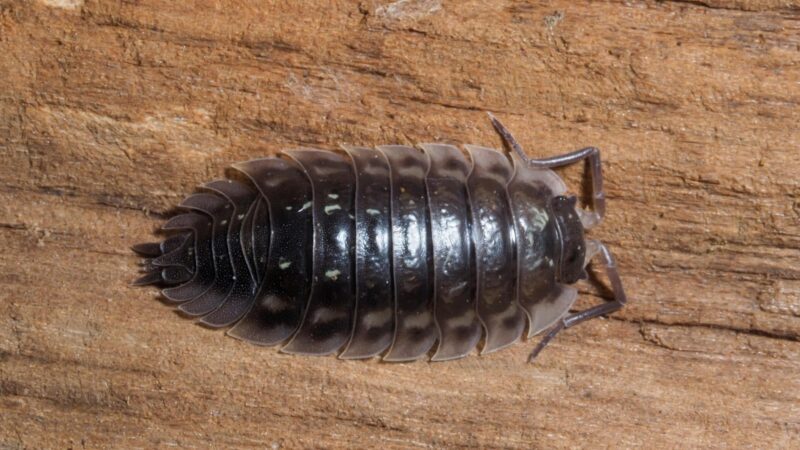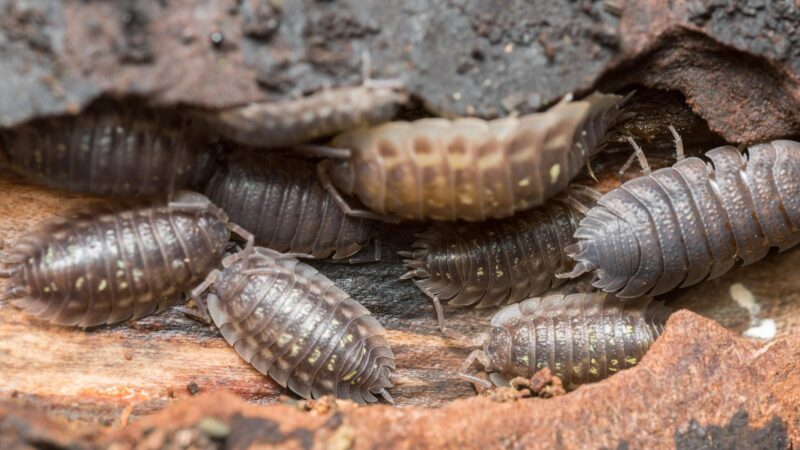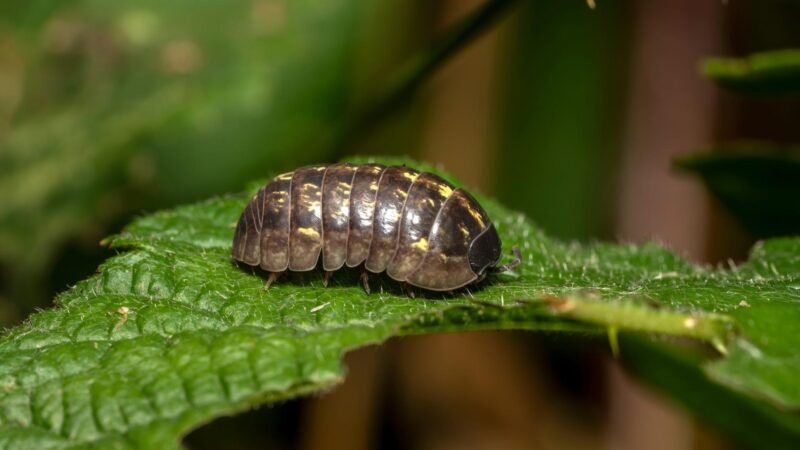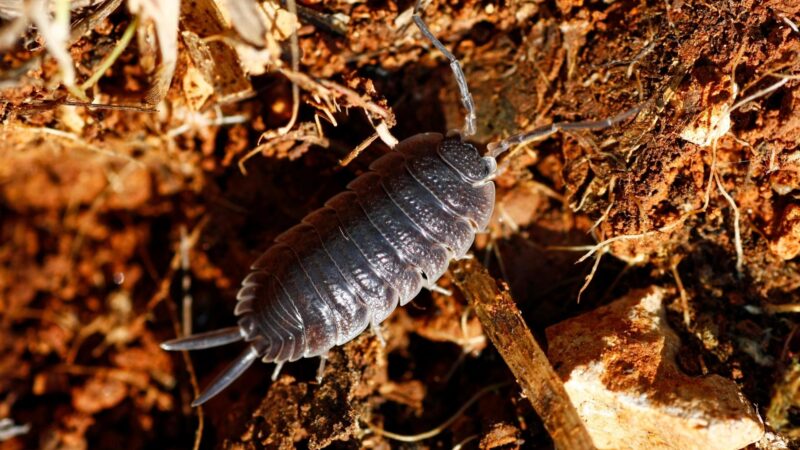If you spot some tiny crawlers in moist wood that look like centipedes but are not, they are very likely to be woodlice. If you also think that only termites love to eat wood, you are wrong.
Woodlice are not as bad as you think. However, multiple woodlice could be unhealthy for your garden and should be eliminated.
How do you get rid of woodlice in the house? To get rid of woodlice, you can trap them or remove their habitat and food sources. You must also reduce humidity levels inside your house. But before doing anything, you should know first how to identify them correctly and understand their behaviors, as well as their purpose.
Woodlice are called terrestrial isopods. They have other common names, such as slater and sowbug, which is their collective name in North America. Also, woodlice are not related to head lice.
They are not even insects. In this complete guide, you will learn everything about woodlice and how to deal with them.
Table of Contents
What Do Woodlice Look Like?

Scientifically known as Oniscidea, woodlice look like millipedes, but they are not related. They are crustaceans and relatives of crabs, lobsters, and shrimp.
They are brown or gray, 0.1-1.1 inches (2.54-27.9 mm) long, and their bodies are divided into 7 segments. Each segment has 2 legs, thus woodlice have a total of 14 legs.
Woodlice are wingless, but they have two pairs of antennae – one long pair and one very short pair. Their flat, elliptical bodies are covered with a bumpy exoskeleton.
They also look like pillbugs (Armadillidium vulgare), except that the latter have no posterior appendages, which means they curl up when disturbed.
Do Woodlice Have Eyes?
Woodlice do have eyes. In fact, they have two compound eyes very near their antennae. Their eyes have 25 individual ocelli, which help them recognize huge moving objects, lights, and shades.
However, woodlice are sensitive to light, and they cannot see high-resolution images. Hence, they are nocturnal creatures.
How Do You Tell the Difference Between a Male and Female Woodlice?

Since woodlice are very tiny, it is quite difficult to determine their gender under an untrained eye. But with the aid of a magnifying glass, you will notice that female woodlice have a brood pouch (marsupium), where they incubate fertilized eggs until they hatch. This pouch is located between their first and fifth pair of legs.
On the other hand, male woodlice have a genital projection near their abdomen. Interestingly, males can change into females if they are infected with bacteria called Wolbachia.
These males shall pass the bacteria to their offspring, causing them to be all females. This phenomenon can affect the third generation.
Where Do Woodlice Live and Why?

Most crustaceans live in water, but woodlice live on land because their bodies are not entirely waterproof. When outdoors, they live in cool damp areas such as under the boards, flower pots, and stones.
Woodlice cannot swim but can survive underwater for about one hour. Just like fish, they breathe through their gills.
Woodlice Diet

Do Woodlice Eat Wood?
Woodlice eat wood and like eating rotting or damp wood. They also eat paper and books. Interestingly, their name “woodlice” came from the fact that they are mostly found in old wood.
The Wolbachia bacteria inside their bodies help them a lot in digesting cellulose, which is the main component in wood and paper.
Do Woodlice Eat Potatoes?
Woodlice eat potatoes, particularly those that are left on the ground. They also eat dead roots, fallen leaves, fungi, leaf litter, and mushrooms.
Woodlice are generally herbivores, which means they eat plants and vegetables, But if food is scarce, these hungry scavengers will eat their own poop and dead woodlice.
Do Woodlice Eat Fruit?
Woodlice eat fruits but not only the rotten ones. Instead, they eat rotting and fresh fruits of all kinds. This includes cucumbers, strawberries, and tomatoes that fall into the ground. In general, sowbugs eat all kinds of decaying organic matter. They also drink water through their rear ends instead of their mouthparts.
Do Woodlice Leave Droppings?
Woodlice leave droppings. Aside from hungry adults, mancas (or young woodlice) eat the poop of the adult ones. These feces will act as microbial enzymes during their developmental stages.
Woodlice don’t pee as other animals do. Instead, they release waste through their shells in the form of ammonia vapor.
What Causes Woodlice in the House?
Woodlice are very attracted to houses with damp wood and decaying matter. These terrestrial isopods enter homes through tiny cracks and crevices, poorly sealed doors, and windows.
Then, they hide in dark, wet areas such as bathrooms and under kitchen sinks. Woodlice are very common indoors during summer.
What Damage Do Woodlice Cause?
Fortunately, woodlice don’t cause significant damage to wooden furniture, wooden floors, and healthy plants. Nevertheless, they may accidentally destroy very soft plant tissues and seedlings while foraging in the soil.
But then, woodlice are not considered destructive pests. They also don’t bite, bite, or carry diseases.
What Is the Purpose of Woodlice?
Woodlice are dubbed as one of nature’s prolific recyclers. Since they eat dead leaves and other rotting organic matter, these land-based crustaceans help in recycling vital nutrients in the soil.
Therefore, woodlice play a very important role in keeping garden plants healthy. In short, they are beneficial to the environment.
According to a study, woodlice can potentially also be used as bioindicators in the assessment of heavy metal pollution. This is because they take heavy metals (such as arsenic, cadmium, and lead) from the soil and ionize them.
For this reason, woodlice could be more than just effective system regulators of our ecosystem.
What Eats Woodlice?
Woodlouse hunters (Dysdera crocata) eat woodlice exclusively. Nevertheless, the other natural predators of woodlice are birds, centipedes, granddaddy longlegs, ground beetles, toads, and wasps. Woodlice are edible, too. When properly boiled, they are a good source of protein and somehow taste like shrimp.
How Do You Catch Woodlice?
Woodlice are very persistent creatures. Although they offer some benefits, you don’t want them to populate your garden. If you have problems raising your plants and placing crushed eggshells does not seem to work well, you might want to catch them alive. Here are some tips on how to make a woodlice trap:
- Place some damp newspaper on the ground near your plants.
- Put small stones on them so they won’t be blown away.
- As bait, put some cut strawberries, potatoes, or tomatoes on them.
- Woodlice are nocturnal creatures, so leave the traps overnight.
- Once the traps catch woodlice, dump them in soapy water.
How Do You Get Rid of Woodlice on Strawberries?
As mentioned earlier, woodlice eat strawberries. Just like us, these sowbugs will patiently wait for strawberry trees to grow and bear fruits. But since they are not as busy as humans, woodlice could be eating your fruits before you know it. To help you out, here are some useful tips to get rid of woodlice in strawberries:
- Sprinkle Food-grade Diatomaceous Earth (DE) directly into dry soil. This non-toxic, organic insecticide kills woodlice on contact.
- Avoid placing wet wood near or around your strawberry trees.
- Reduce damp and dark mulch in your garden.
- Place sharp barriers around your trees. You may use crushed eggshells or oyster shells.
- Raise your strawberry plants by placing them in hanging baskets several inches above the ground.
How Do You Get Rid of Woodlice in Your Home Naturally?
Trapping woodlice are effective, but you need patience. On the other hand, using insecticide sprays can harm your plants. Aside from that, woodlice may keep on coming back, and you may need to spray frequently.
For long-term solutions, here are some natural ways to prevent woodlice or sowbugs from entering your home:
- Let the soil get completely dry before watering your garden and indoor plants again.
- Check firewood for woodlice before bringing them into your house.
- Regularly prune plants that are very near your windows and outdoor walls.
- Don’t let fallen leaves, fruits, and debris accumulate on the ground.
- Always keep your gutter clean and dry.
- If woodlice are already inside your house, sweep them out or use a portable vacuum cleaner.
- Without moisture, woodlice die quickly. Install a portable dehumidifier such as Pro Breeze Electric Mini Dehumidifier and set it to about 60%.
- Repair or replace damaged screens on windows and doors.
- Seal all cracks and crevices using a reliable sealant such as Gorilla White 100% Silicone Sealant Caulk.
- To fill in the gap between the floor and door frames, install a weather stripping material such as Silicone Seal Strip.
- Alternatively, install a door sweep such as the Baining Door Draft Stopper at the bottom of your door.
Summary
Outdoors, woodlice offer lots of benefits than harm. Indoors, they don’t cause any trouble, except for being an annoying sight. Therefore, you should avoid killing them.
The best way to get rid of them is to not allow them to be on your property. If an infestation becomes uncontrollable, call a licensed pest control service company.
List of Sources
Woodlice (Isopoda: Oniscidea): Their Potential for Assessing Sustainability and Use as Bioindicators